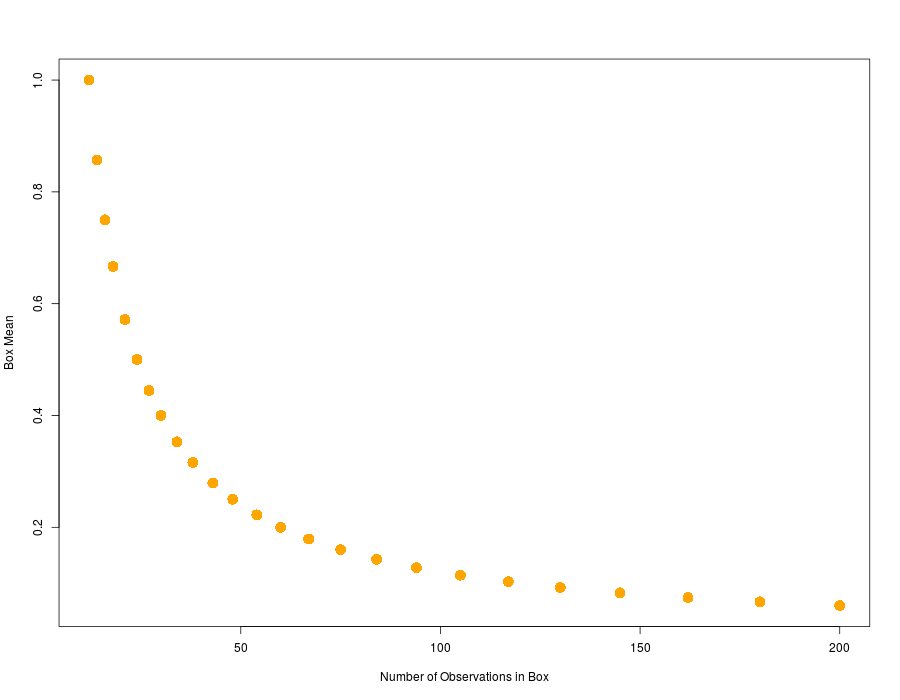模拟:Fig. 9.7¶
| 原文 | 9.3 PRIM |
|---|---|
| 作者 | szcf-weiya |
| 发布 | 2018-03-17 |
生成数据¶
首先生成在单位方格中均匀分布的点,
## generate data
N = 200
set.seed(123)
x1 = runif(N, 0, 1)
x2 = runif(N, 0, 1)
cl = ifelse(x1<0.8 & x1>0.5 & x2>0.4 & x2 < 0.6, 1, 0)
df = data.frame(x1, x2, cl)
作图函数¶
为了作出类似图 9.3 的图,自定义如下绘图函数
## plot box
plot.box <- function(df, id, fcut){
plot(0:1, 0:1, type = "n",
xaxt="n", yaxt="n",
xlab = "", ylab = "",
main = paste("Step ", id))
df1 = df[df$cl==1, ]
df0 = df[df$cl==0, ]
points(df0$x1, df0$x2, col="blue")
points(df1$x1, df1$x2, col="red")
## face 1 & 3
clip(0, 1, fcut[4], fcut[2])
abline(v = c(fcut[1], fcut[3]), lwd=2)
## face 2 & 4
clip(fcut[3], fcut[1], 0, 1)
abline(h = c(fcut[2], fcut[4]), lwd=2)
}
主函数 PRIM¶
这里例子中没有体现出 PRIM 的 “pasting” 特点,只需要不断进行 “peeled”。
simplePRIM <- function(df, alpha=0.1, n1=5, n2=5){
par(mfrow=c(n1, n2), mar=c(1,1,1,1))
nstep = 0
box = df
fcut = c(1, 1, 0, 0)
fmu = numeric(n1*n2)
fn = numeric(n1*n2)
for (nstep in 0:(n1*n2-1)){
fn[nstep+1] = nrow(box)
fmu[nstep+1] = mean(box$cl)
cat("step", nstep, " current mean = ", fmu[nstep], "\n")
plot.box(df, nstep, fcut)
## face 1
f1.cut = quantile(box$x1, 1-alpha)
f1.box = box[box$x1 < f1.cut, ]
f1.mu = mean(f1.box$cl)
## face 2
f2.cut = quantile(box$x2, 1-alpha)
f2.box = box[box$x2 < f2.cut, ]
f2.mu = mean(f2.box$cl)
## face 3
f3.cut = quantile(box$x1, alpha)
f3.box = box[box$x1 > f3.cut, ]
f3.mu = mean(f3.box$cl)
## face 4
f4.cut = quantile(box$x2, alpha)
f4.box = box[box$x2 > f4.cut, ]
f4.mu = mean(f4.box$cl)
## choose the max one
ind = which.max(c(f1.mu, f2.mu, f3.mu, f4.mu))
box.list = list(f1.box, f2.box, f3.box, f4.box)
cut.vec = c(f1.cut, f2.cut, f3.cut, f4.cut)
box = box.list[[ind]]
fcut[ind] = cut.vec[ind]
}
return(list(means=fmu, cutpoint = fcut, final.box=box, n=fn))
}
结果¶
运行下面代码,完美重现了图 9.7 和 图 9.8 的结果
## run code
res = simplePRIM(df)
## plot the mean profile
plot(res$n, res$means, col="orange", pch=16, cex=2,
xlab="Number of Observations in Box",
ylab="Box Mean")

